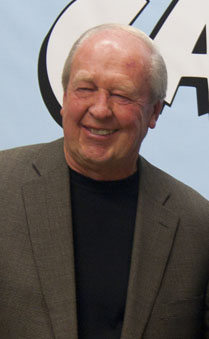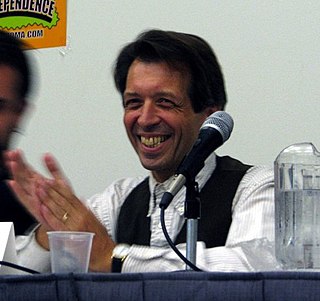Related Research Articles

A comic strip is a sequence of cartoons, arranged in interrelated panels to display brief humor or form a narrative, often serialized, with text in balloons and captions. Traditionally, throughout the 20th and into the 21st century, these have been published in newspapers and magazines, with daily horizontal strips printed in black-and-white in newspapers, while Sunday papers offered longer sequences in special color comics sections. With the advent of the internet, online comic strips began to appear as webcomics.

Peanuts is a syndicated daily and Sunday American comic strip written and illustrated by Charles M. Schulz. The strip's original run extended from 1950 to 2000, continuing in reruns afterward. Peanuts is among the most popular and influential in the history of comic strips, with 17,897 strips published in all, making it "arguably the longest story ever told by one human being". At the time of Schulz's death in 2000, Peanuts ran in over 2,600 newspapers, with a readership of around 355 million in 75 countries, and was translated into 21 languages. It helped to cement the four-panel gag strip as the standard in the United States, and together with its merchandise earned Schulz more than $1 billion.

James Robert Davis is an American cartoonist, screenwriter, and producer. He is best known as the creator of the comic strips Garfield and U.S. Acres. Published since 1978, Garfield is one of the world's most widely syndicated comic strips. Davis's other comics work includes Tumbleweeds, Gnorm Gnat, and Mr. Potato Head.
Tom the Dancing Bug is a weekly satirical comic strip by cartoonist and political commentator Ruben Bolling that covers mostly US current events from a liberal point of view. Tom the Dancing Bug won the 2002, 2003, 2007, 2008, and 2009 Association of Alternative Newsweeklies Awards for Best Cartoon. The strip was awarded the 2010 Sigma Delta Chi Award for editorial cartooning by the Society of Professional Journalists and best cartoon in the 2018 Robert F. Kennedy Book & Journalism Awards. His work on the strip won Bolling the 2017 Herblock Prize and the 2021 Berryman Award for Editorial Cartoons, and he was a finalist in the Editorial Cartooning category for the 2019 and 2021 Pulitzer Prize.

Alan Grant was a British comic book writer known for writing Judge Dredd in 2000 AD as well as various Batman titles from the late 1980s to the early 2000s. He was the co-creator of the characters Anarky, Victor Zsasz, and the Ventriloquist.

King Features Syndicate, Inc. is an American content distribution and animation studio, consumer product licensing and print syndication company owned by Hearst Communications that distributes about 150 comic strips, newspaper columns, editorial cartoons, puzzles, and games to nearly 5,000 newspapers worldwide. King Features Syndicate also produces intellectual properties, develops new content and franchises, like The Cuphead Show!, which it produced with Netflix, and licenses its classic characters and properties.

Richard Allen Kulpa was an American cartoonist best known for his work for Cracked and Weekly World News.
Notable events of 2006 in comics.

Louis Kenneth Fine was an American comic book artist known for his work during the 1940s Golden Age of comic books, where his draftsmanship became an influential model to a generation of fellow comics artists.
Lancer Books was a publisher of paperback books founded by Irwin Stein and Walter Zacharius that operated from 1961 through 1973. While it published stories of a number of genres, it was noted most for its science fiction and fantasy, particularly its series of Robert E. Howard's Conan the Barbarian tales, the first publication of many in paperback format. It published the controversial novel Candy by Terry Southern and Mason Hoffenberg, and Ted Mark's ribald series The Man from O.R.G.Y. Lancer paperbacks had a distinctive appearance, many bearing mauve or green page edging.
Nantier Beall Minoustchine Publishing Inc. is an American graphic novel publisher. Founded by Terry Nantier in 1976 as Flying Buttress Publications, NBM is one of the oldest graphic novel publishers in North America. The company publishes English adaptations and translations of popular European comics, compilations of classic comic strips, and original fiction and nonfiction graphic novels. In addition to NBM Graphic Novels, the company has several imprints including ComicsLit for literary graphic fiction, and Eurotica and Amerotica for adult comics.
Downstown was an American syndicated comic strip created by Tim Downs that ran from 1974 to 1986.
KYFI is a Conservative Christian radio station broadcasting from St. Louis, Missouri. KYFI is owned and operated by Bible Broadcasting Network, Inc. KYFI's transmitters are located near Gateway Motorsports Park in Madison, Illinois.

Batton Lash was an American comics creator who came to prominence as part of the 1990s self-publishing boom. He is best known for the series Wolff and Byrd, Counselors of the Macabre, a comedic series about law partners specializing in cases dealing with archetypes from the horror genre, which ran as a strip in The National Law Journal, and as a stand-alone series of comic books and graphic novels. He received several awards for his work, including an Inkpot Award, an Independent Book Publishers Association's Benjamin Franklin Award, an Eisner Award, and nominations for two Harvey Awards.
KQQZ was a commercial AM radio station that was licensed to serve Fairview Heights, Illinois, on 1190kHz, and broadcast from 1968 to 2020.

Chop Shop is a 2004 crime novel by American writer and speaker Tim Downs. It was published in 2004 by Howard Books and was preceded by Shoofly Pie.

Benjamin David "Stookie" Allen was a cartoonist who specialized in nonfiction and inspirational features. He created the nationally syndicated comic strips Heroes of Democracy and Keen Teens. For the pulps, he created and drew Argosy magazine's Men of Daring and Women of Daring, and Detective Fiction Weekly's Illustrated Crimes.
The 1923 Missouri Tigers football team was an American football team that represented the University of Missouri in the Missouri Valley Intercollegiate Athletic Association during the 1923 college football season. The team compiled a 2–3–3 record, finished in eighth place in the Missouri Valley conference, and was outscored by all opponents by a combined total of 40 to 31. Gwinn Henry was the head coach for the first of nine seasons. The team played its home games at Rollins Field in Columbia, Missouri.
The 1925 Washington University Pikers football team was an American football team that represented Washington University in St. Louis as a member of the Missouri Valley Conference during the 1925 college football season. In its first season under head coach Bob Higgins, the team compiled a 2–5–1 record and was outscored by a total of 95 to 29. The team played its home games at Francis Field in St. Louis.
The 1933 Washington University Bears football team was an American football team that represented Washington University in St. Louis as a member of the Missouri Valley Conference (MVC) during the 1933 college football season. Led by second-year head coach Jimmy Conzelman, the Bears compiled an overall record of 4–5 with a mark of 1–2 in conference play, placing fourth in the MVC.
References
- 1 2 3 4 5 6 7 McGuire, John M. (March 24, 1980). "Artist Isn't Doodling; He's Syndicated at 25". St. Louis Post-Dispatch. p. 3D. Retrieved January 29, 2022– via Newspapers.com.
- 1 2 3 4 "Hagar Replacing Flash; Darling Going". St. Louis Post-Dispatch. March 8, 1980. p. 2E. Retrieved January 29, 2022– via Newspapers.com.
- 1 2 3 4 Jaffie, Karin (November 2, 1984). "Cartoonist Confronts Stereotypes from Biblical Perspective". The Forum. p. 2. Retrieved January 29, 2022– via Newspapers.com.
- ↑ Hall, Marilyn (May 25, 1967). "Des Peres Data". The Webster Advertiser. p. 13. Retrieved January 29, 2022– via Newspapers.com.
- 1 2 3 4 5 6 7 Archibald, John J. (February 2, 1986). "Juliet Proves Hearty; Downstown Gone". St. Louis Post-Dispatch. p. 2C. Retrieved January 29, 2022– via Newspapers.com.
- 1 2 3 "Tim Downs". www.moodypublishers.com. Retrieved 2022-01-29.
- 1 2 3 4 5 6 7 8 Solomon, Charles (February 1, 1986). "'Downstown' Creator is Facing a Downtime". Los Angeles Times. Retrieved January 29, 2022– via Newspapers.com.
- 1 2 3 "Two New Comic Strips to Begin Monday". The Republic. March 28, 1980. p. 1. Retrieved January 29, 2022– via Newspapers.com.
- 1 2 3 4 Moore, C. E. "Tim Downs Brings the Bug Man". www.newreleasetoday.com. The Christian Manifesto. Retrieved 2022-01-29.
- ↑ Solomon, Charles (October 11, 1981). "Proof that It's the Little Absurdities that Count". The Los Angeles Times . p. 34. Retrieved January 29, 2022– via Newspapers.com.
- ↑ "Downstown". Vidette-Messenger of Porter County. January 23, 1981. p. 4. Retrieved January 29, 2022– via Newspapers.com.
- ↑ "Downstown Offers Laid-Back Humor". Edmonton Journal . March 22, 1980. p. B1. Retrieved January 29, 2022.
- ↑ "Two Add Fun on the Daily Comics Page". The Miami News. July 14, 1980. p. 1. Retrieved January 29, 2022– via Newspapers.com.
- 1 2 3 4 Volland, Victor (March 3, 1985). "Cartoonist Tackles Famine Relief". St. Louis Post-Dispatch. p. 13A. Retrieved January 29, 2022– via Newspapers.com.
- ↑ Wood, Sue Ann (February 24, 1985). "Making a Point in the Comics". St. Louis Post-Dispatch. p. C1. Retrieved January 29, 2022.
- 1 2 Wood, Sue Ann (January 26, 1986). "Fans". St. Louis Post-Dispatch. p. D1. Retrieved January 29, 2022– via Newspapers.com.
- ↑ Downs, Tim (January 29, 1986). "Downstown". St. Louis Post-Dispatch. p. 7F. Retrieved January 28, 2022– via Newspapers.com.
- ↑ Downs, Tim (January 28, 1986). "Downstown". St. Louis Post-Dispatch. p. 7D. Retrieved January 29, 2022– via Newspapers.com.
- ↑ Downs, Tim (February 1, 1986). "Downstown". St. Louis Post-Dispatch. p. 7D. Retrieved January 29, 2022– via Newspapers.com.
- 1 2 3 4 "Books by Tim Downs". GoodReads.com. January 19, 2022. Retrieved 2022-01-30.
- 1 2 3 4 5 6 "Downs, Tim | Encyclopedia.com". www.encyclopedia.com. Retrieved 2022-01-29.
- 1 2 "A Bug Man's Life". The News and Observer. January 18, 2005. p. 5E. Retrieved January 29, 2022– via Newspapers.com.
- ↑ "Fiction Book Review: Nick of Time by Tim Downs". Publishers Weekly. May 2012. Retrieved 2022-01-30.
- ↑ "Bug Man". World Cat. February 2, 2022. Retrieved 2022-02-03.
- ↑ "Fiction Book Review: Chop Shop: A Bug Man Novel by Tim Downs". Publishers Weekly. January 20, 2004. Retrieved 2022-01-29.
- 1 2 3 "Christian Author Awarded". The News and Observer . April 29, 2004. p. 84. Retrieved January 29, 2022– via Newspapers.com.
- ↑ Phillips, Fred (June 29, 2005). "Howard Publishing, Downs' Novel Awarded". The News-Star. p. 4D. Retrieved January 29, 2022– via Newspapers.com.
- ↑ "Fiction Book Review: First the Dead by Tim Downs". Publishers Weekly. January 2008. Retrieved 2022-01-30.
- 1 2 "Fiction Book Review: Wonders Never Cease by Tim Downs". Publishers Weekly. May 2010. Retrieved 2022-01-30.
- ↑ "Fiction Book Review: Head Game by Tim Downs". Publishers Weekly. January 9, 2009. Retrieved 2022-01-30.
- ↑ "Wonders Never Cease is the Perfect Summer Read and Book Club Selection for 2010". Cision. June 19, 2010. Retrieved January 29, 2022.
- ↑ "Plague Maker". Kirkus Reviews. October 15, 2005. Retrieved January 29, 2022.
- ↑ "Fiction Book Review: Plaguemaker by Tim Downs, Author". Publishers Weekly. January 10, 2006. Retrieved 2022-01-30.
- 1 2 "Where the Wind Leads". Kirkus Reviews. March 1, 2014. Retrieved 2022-01-30.
- 1 2 "Religion Book Review: Fight Fair! Winning at Conflict Without Losing at Love". Publishers Weekly. August 2003. Retrieved 2022-01-30.
- ↑ "Tim Downs". World Cat. February 2, 2022. Retrieved February 2, 2022.